7 October 2020
Why creativity is the most important competition for the future of humanity and the planet
By Ana Moreno
Covid-19 has put the world in check, every system is wobbling, including education. Old dynamics and ways of thinking no longer work to get out of this. And so, innovation is required, i.e, doing things differently. This will be possible thanks to a great old friend though still quite unknown to many: creativity.
According to the recently deceased Professor Sir Ken Robinson, who is our protagonist today, it is the most abundant and also most necessary natural human capacity for the survival of the human being.
In 2006, in the TED conference in California, Sir Ken gave a death knell to the educational world: “schools are killing creativity”. His cry was heard all over the planet: over 60 million visualizations, an estimated 380 million people in 160 countries listened to his words. No one was left indifferent; he seemed to be a visionary to some, a madman to others, and not a few saw him as a provocateur seeking popularity. However, our opinion will surely be different if we tackle the same lecture again today. In his 20 minutes talk, he recalls three aspects in a pleasant and sympathetic way: the extraordinary evidence of the creative capacity with which each human being is born, that we have no idea what will happen in the future and, finally, the interest education awakens at all levels.
But who was Ken Robinson? He was a Knight of Queen Elizabeth II of England since 2003; why did he deserve this honour and how did he come to lead such an educational revolution?
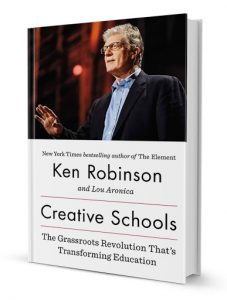
Creativity is the natural human capacity, more abundant and also more necessary for the survival of the human being.
Sir Ken Robinson
Ken Robinson was born in 1950 to a working-class family of seven children. At the age of four, he contracted polio, which left him with significant consequences and forced him to attend a special needs school. When he was still a child, his father had an accident at work that left him a quadriplegic. However, thanks to his determination and the support of his family, he managed to study at university and end his doctorate. His doctoral thesis studied the possibilities of drama and theatre in education.
Amongst his many consultancy, teaching and research projects, he was the director of “The Arts in Schools Project”, one to improve the learning of the arts in schools in England and Wales. He taught Art Education for 12 years at Warwick University, serving as spokesperson for the department itself and ending up as Professor Emeritus at the same university.
In the late 90s, the British Minister of Education and Employment appointed him to a national advisory committee on creative education and culture. This commission carried out the largest national research on the importance of creativity in education and the UK economy. It published the so-called Robinson Report, whose real title was “All our futures: creativity, culture and education”. The article highlighted the limited role that creativity had hitherto played and the importance it held in the future, both for the country and humanity itself. The Times published the following about the report:
This report raises some of the most important issues facing business in the 21st century. It should have every CEO and HR director banging on the table and demanding action.
He used creativity to resolve conflicts of all kinds and worked with ministers; he became the central figure in creating a strategy for the development of creativity and the economy that was part of the Peace Process with Northern Ireland.
Ken Robinson was one of four international advisors to the Singapore government in creating their strategy to become the creative environment for Southeast Asia. He was acclaimed by Fast Company Magazine as one of the elite thinkers in creativity and innovation.
In 2003 Queen Elizabeth II knighted him for his services to the arts. In addition, Sir Ken was happy to support charities.
His thoughts are recorded in three of his major books. The first of these was published in 2001 Out of our Minds: Learn to be Creative. John Cleese said, “Ken Robinson writes brilliantly about the different ways in which creativity is undervalued and ignored in Western culture and especially in our national education systems”. His second book The Element: How to find your passion, can change everything was published by Penguin in 2009 and translated into 21 languages. The element refers to the experience of the moment when personal talent meets personal passion. In this encounter, he argues, we feel more ourselves, are more inspired and achieve the best. The book is based on stories of creative artists. Creative Schools was printed in 2015; it is inspired by his famous TED talk How School Kills Creativity. He sought to offer an answer to all those who did not understand the revolution he was talking about in his session.
All his work takes on a special dimension at times like the current ones, as his reformist proposals on education and the role of creativity are no longer merely ideas but have become a matter of urgency for all the world’s education systems.
This article is dedicated to collecting part of his great legacy. Some of the most representative ideas on his passion, i.e. the improvement of education, have been chosen to this end and have been included in his book Creative Schools.
His reformist proposals on education and the role of creativity are no longer merely ideas but have become a matter of urgency for all the world’s education systems.
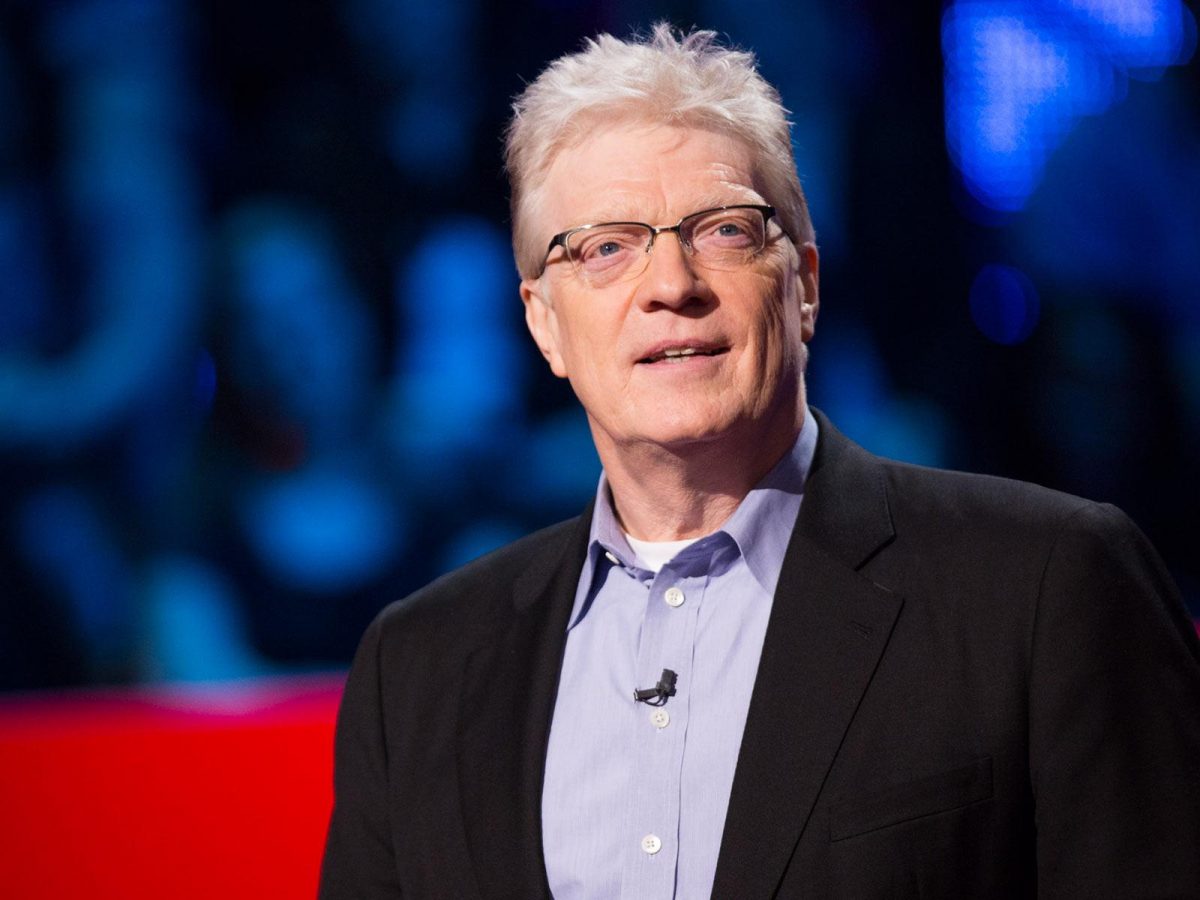
Sir Ken’s best ideas for the present transformation required
Civilization is a race between education and catastrophe. H. G, Wells
Education needs a transformation
Education is indeed our greatest hope. However, the old-style fruit of the Industrial Revolution is no longer an answer to our needs: a new educational system is required to help us face the current challenges and enhance the natural talents that we all have inside. It is not a question of repairing the system but of changing and transforming it.
Purpose of education
The first step for transforming school is to review what we understand by education. The purpose of education is to enable students to understand the world around them and to discover their natural talents. By doing so, they will fulfil themselves as individuals and become active and compassionate citizens.
Education is our greatest hope. We need a new educational system that helps us face the challenges of today and that enhances the natural talents that we all have within us. It is not a question of repairing the system but of changing and transforming it.
How can you be part of this change?
We can start by distinguishing three forms of discernment: a critique of the current situation, a vision of how it should be, and a transformative theory for moving from one to the other. In his book, the author suggested bringing these three aspects together, based on his own experience and that of many others and drawing on research and some principles.
This revolution is based on faith in the value of the individual; on the right to self-determination; on the potential for evolution and personal fulfilment of human beings; and on the importance of civic responsibility and respect for others.
Why is education such a hot topic in politics?
Education has a decisive influence on prosperity. Over the past twenty-five years, rapid advances in digital technology and high population growth have transformed the business sector. Governments know that an educated workforce is critical to national economic prosperity.
The second reason is cultural. Education is one of the main ways in which communities pass their values and traditions from one generation to the following.
The third reason is social. One of the goals of education is to provide all students with opportunities to thrive and become active, committed citizens, regardless of their social status,
And the fourth reason is a personal one. It is essential for all learners to become aware of their dignity and potential, and to be able to lead full and productive lives.
But improving school performance is not easy. Many factors need to be considered: lack of motivation, poverty, social marginalization, family circumstances, lack of infrastructure and funding of schools, the pressure examinations and assessments involve, etc.; but the low quality of education and teaching methods are also important.
Research and practical experience repeatedly show that motivation and expectations of pupils are determining factors for increasing school performance.
But the policy response has been contrary to the recommended one: content, teaching and assessment standardization rather improving the quality of teaching, having a broad and balanced curriculum and applying formative and comprehensive assessment systems. Doing so, more problems are created than solved. This failure is partly because people are not all the same and neither are their abilities and personalities.
Education should offer all learners the same opportunities to explore their true abilities and thus to fulfil themselves in life. However, the system seems to be bent on creating people according to certain concepts of talent and economic need, and so destined to produce winners and losers.
Change occurs when three fundamental aspects are combined: the possibility of radical innovations within the educational system; the power of far-sighted leaders to bring about these changes; and the need for principals and teachers to create the right conditions in schools for students to develop their full potential.
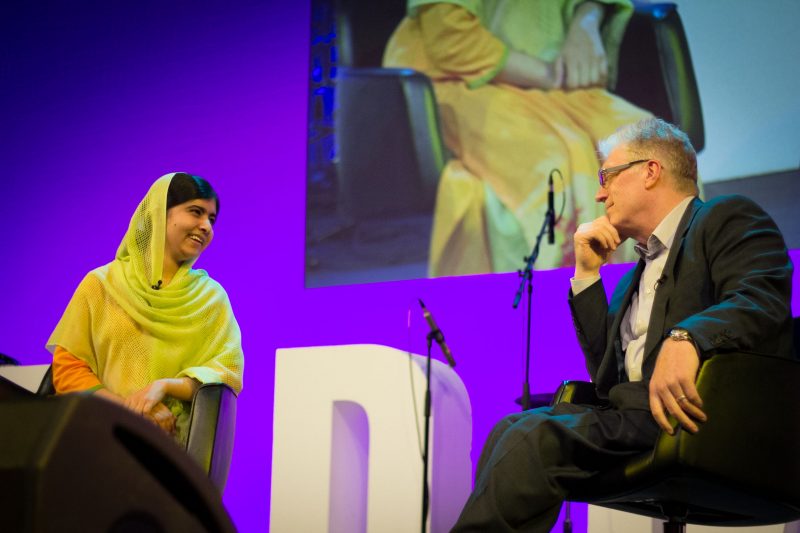
The possibility of radical innovations within the education system creates the need for principals and teachers to create the right conditions in schools for students to develop their full potential.
Education is an organic, non-industrial process
Education deals with living people who have emotions, feelings, talents and life circumstances. They are influenced by what happens and, in turn, influence the lives of others. They may oppose or collaborate, become involved or disengage. It is therefore basic to understand that people develop under certain conditions, not others.
The four fundamental principles of their development would be:
- Health: well-being of the student as a whole: intellectual, physical, spiritual and social
- Ecology: key interdependence of all these aspects of the development of each student and in the community as a whole
- Justice: to cultivate the talents and potential of all students, regardless of their circumstances, and to respect the roles and responsibilities of those who work with them
- Caution: creating optimal conditions for human development based on compassion, experience and practical wisdom.
The aim is to invigorate an organic culture within the centres themselves.
The culture of the school and the aims of education
The culture of the schools should meet the four goals of education:
- Economic: “Education should enable students to become economically responsible and independent. This new challenge is to promote educational models that encourage young people to become involved in global economic issues related to environmental sustainability and well-being, i.e. to orient them towards economic activities that encourage respect and renewal of natural resources rather than those that exploit and deplete the environment.
- Cultural: “Education should enable students to understand and value their own culture and respect all others. The cultural priorities of schools should be threefold: 1) helping pupils understand their culture; 2) learning about cultures other than their own; 3) fostering a climate of tolerance and cultural co-existence.
The cultural priorities of schools should be three: 1) helping students understand their own culture; 2) getting to know cultures other than their own; 3) fostering a climate of tolerance and cultural coexistence.
- Social: “Education must empower young people to become active and compassionate citizens”. To this end, schools must become environments that practice principles of civic and democratic citizenship in their daily operations.
- Personal: “Education must enable young people to relate to their inner world, as well as to the world around them”. Education is about enriching the minds and hearts of human beings. What people bring to their environment is largely determined by how they live their inner world. Personalisation requires a cultural change, which has an impact on the curriculum, teaching methods and assessment.
Education is about enriching the minds and hearts of human beings. What people bring to their environment is largely determined by how they live their inner world.
Eight core competencies
The four aims of education, in turn, suggest eight key competencies that schools should provide to their students in order to succeed in their lives:
- Curiosity: the ability to ask questions and explore how the world works
- Creativity: competence to generate new ideas and put them into practice
- Criticism: the capacity to analyse information and ideas and develop arguments and reasoned judgements
- Communication: ability to express thoughts and feelings clearly and confidently in a variety of media and forms
- Collaboration: skills to collaborate constructively with others
- Compassion: the capability to put yourself in other people’s shoes and act accordingly.
- Calm: talent to connect with the emotional life within and develop a sense of personal harmony and balance.
- Civility: the talent to be constructively involved in society and participate in the processes that sustain it.
Find a method
One of the most interesting recent innovations in the field of teaching and learning is what is known as ‘design thinking’. This is a methodology that is currently being applied by many organisations and an increasing number of schools. It is based on the creative and analytical techniques used by professional designers to identify and solve problems and to create new products and services. It is often interdisciplinary and it strongly encourages collaboration. One of the best explanations of its principles and practices is Change by Design: How Design thinking transforms Organizations and inspires innovation, Tim Brown.
The curriculum
Structuring the curriculum around the interests of the students improves their performance in all areas.
Everyone calls for creativity and interdisciplinary thinking. A quality Arts Education encourages students to be willing to accept criticism, to take risks, to imagine, to strive, to collaborate. It also allows them to create their own answers, to defend them critically and to review them. This type of education prepares students to face problems from another perspective.
There are three principles that the curriculum should comply with so that schools can fulfil the four aims of education:
- Diversity: it should be broadly based to encompass the kinds of knowledge we want for all students and provide adequate opportunities for each to discover his or her personal qualities and interests.
- Depth: it should offer an appropriate range of possibilities so that students can go deeper into their areas of interest as they develop.
- Dynamism: it should be structured in such a way as to allow for collaboration and interaction between students of different ages and teachers with different specialities. It should create links with the community and evolve and develop as a result.
A quality arts education encourages students to be willing to accept criticism, to imagine, to make an effort, to collaborate. It allows them to create their own responses and defend them critically.

The assessment
Assessment is the process of making judgements about students’ progress and knowledge. It fulfils several functions: a diagnostic one, another formative and, finally, a cumulative aim.
In all cases, it has two components: descriptive and evaluative. Assessments compare the performance of one person with another and classify it according to certain criteria. One way of giving greater meaning to evaluation is to separate these two concepts. Assessment can be based on very different concepts such as class participation, workbooks, tasks carried out in other formats.
Learning records are an example of an effective alternative to examinations. These were developed in London. They arose from the need to identify the progress in learners for whom the usual methods were not working.
First a photograph is taken of the situation at its beginning and then it is observed for a certain period of time, during which work samples are collected and then analyzed.
Vygotsky offers a model that allows talking about student learning in a multi-purpose way. This method became an effective model in the UK: Teachers were enthusiastic because it meant more creative work and offered a different view of those students who had previously been problematic. It showed students on their learning path, rather than their failures.
Learning records are an effective tool since students take responsibility for their own learning and document it. It is also a way of integrating parental involvement in the school. They can nowadays be obtained free of charge from the www.learningrecord.org website, courtesy of M. A. Syverson.
A picture of the future
In national and global surveys, employers do not complain their applicants lack specific knowledge or some technical skills, as they are easy to qualify and reflect in their CVs; but they want employees who are capable of critical analysis, collaboration, communication, problem-solving and creative thinking.
Both formal and informal assessments should promote learning and performance in three areas:
- Motivation: kkeeping students informed about their performance and encouraging them to improve.
- Performance: providing information about pupils’ work and achievements. Establishing criteria for comparisons between peers and giving feedback on progress and potential.
- Benchmarks: defining clear and consistent reference levels which will enable learners to expand their aspirations and will also contribute to the guidance and practical support they may need to achieve those goals.
Leading with principles
Every great learning experience works on two fundamental figures: the learner and the educator.
For a school to stand out, a third figure is needed: a brilliant leader who brings ideas, experience, and a deep understanding of the kind of environments in which learners can and want to learn.
High performance is driven by motivation and ambition, and great leaders know how to awaken both emotions in a human spirit. They can instil hope in those who have lost it, inspire determination in the desperate and guide the lost. As well as vision, a great leader needs support, means and skills.
School directors
Great principals know that their job is not to improve grades, but to create a sense of community among students, teachers, parents and other staff, who must have common goals. This is more likely to work if everyone involved has enough faith in the necessary changes to give them a chance.
NASSP (National Association of Secondary School Principals) points out three key issues that all principals should take into consideration:
- Leading in partnership. Creating a common vision for the future, developing a defined and sustainable improvement plan, and identifying important roles for teachers and other staff.
- Personalising school environment. Developing personal plans for each student and vanishing anonymity of the centre.
- Curriculum, methodology and evaluation to improve performance. Prioritizing a deep knowledge over a wide one, offering alternatives to separate or group students together according to their academic abilities, linking the subjects they learn with real-life situations.
The centers that stand out have their own dynamics. In general, they all promote the following key characteristics of a culture that promotes learning:
- Community: all members feel part of a caring community that supports their respective needs and hopes.
- Individuality: members feel respected as individuals, each with their own talents, interests and needs.
- Opportunities: hope is instilled and opportunities are offered to all those who are part of the community. It recognises a wide range of talents and provides multiple ways for achieving their aspirations.
Centers that flourish have their own dynamics. In general, they all foster the following key characteristics of a culture that fosters learning: community, individuality, and opportunity.
Creating a school culture
The culture of the school, its values, behaviours and codes of coexistence are what determine the success of this adventure. In order to change schools, it is necessary to analyse their habits and habitats.
Habits: The environmental culture of a school, the attitudes and expectations it creates in both teachers and students are the determining factor in the generation or inhibition, of original ideas. Questioning rooted habits of school culture opens up the development of forms of coexistence that are better adapted to the needs and interests of the community.
Habitats: The atmosphere of a school can be perceived as soon as one goes in. The style and characteristics of the physical environment are not only aesthetic elements; they also influence the mood, motivation and vitality of the whole school community. An effective way to design the school environment is to make it reflect learning concepts and a different and innovative curriculum, just like the Grange school that Richard Gerver and his team transformed into a village.
As a conclusion
Benjamin Franklin was aware that a liberal and effective education was fundamental to make the American dream flourish. He once said that there are three kinds of people: those who are immovable, those who are movable, and those who move. Some people do not see the need of change and do not want to do so: current and time play in favour of renewal, so it is possible that the winds of change will leave them behind.
Benjamin Franklin once said that there are three kinds of people: those who are immovable, those who are movable, and those who move.
Those who are mobile see the need for change. Work with them and stimulate their energy; create partnerships and forge dreams and plans.
Finally, there are those who move: they represent the agents of change who are able to imagine a different future and who are determined to make it happen by acting personally and collaborating with others. They know that they do not always need to be entitled to do so. As Gandhi said, if we want to change the world, we must be the change we want to see. Because, when many people move, that creates movement. And if this movement has enough energy, then it becomes a revolution. And that is just what we need in the educational field.

Those who move represent the agents of change who are able to imagine a different future and who are determined to make it happen by acting personally and collaborating with others.
Dear Sir Ken, thank you very much for fighting to leave the world much better than the one you found it. May you rest in peace.
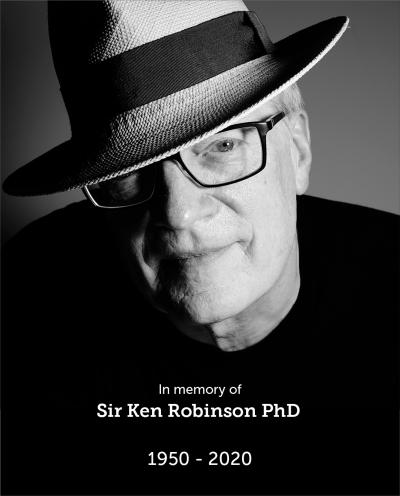
Related to: Article
You might also like



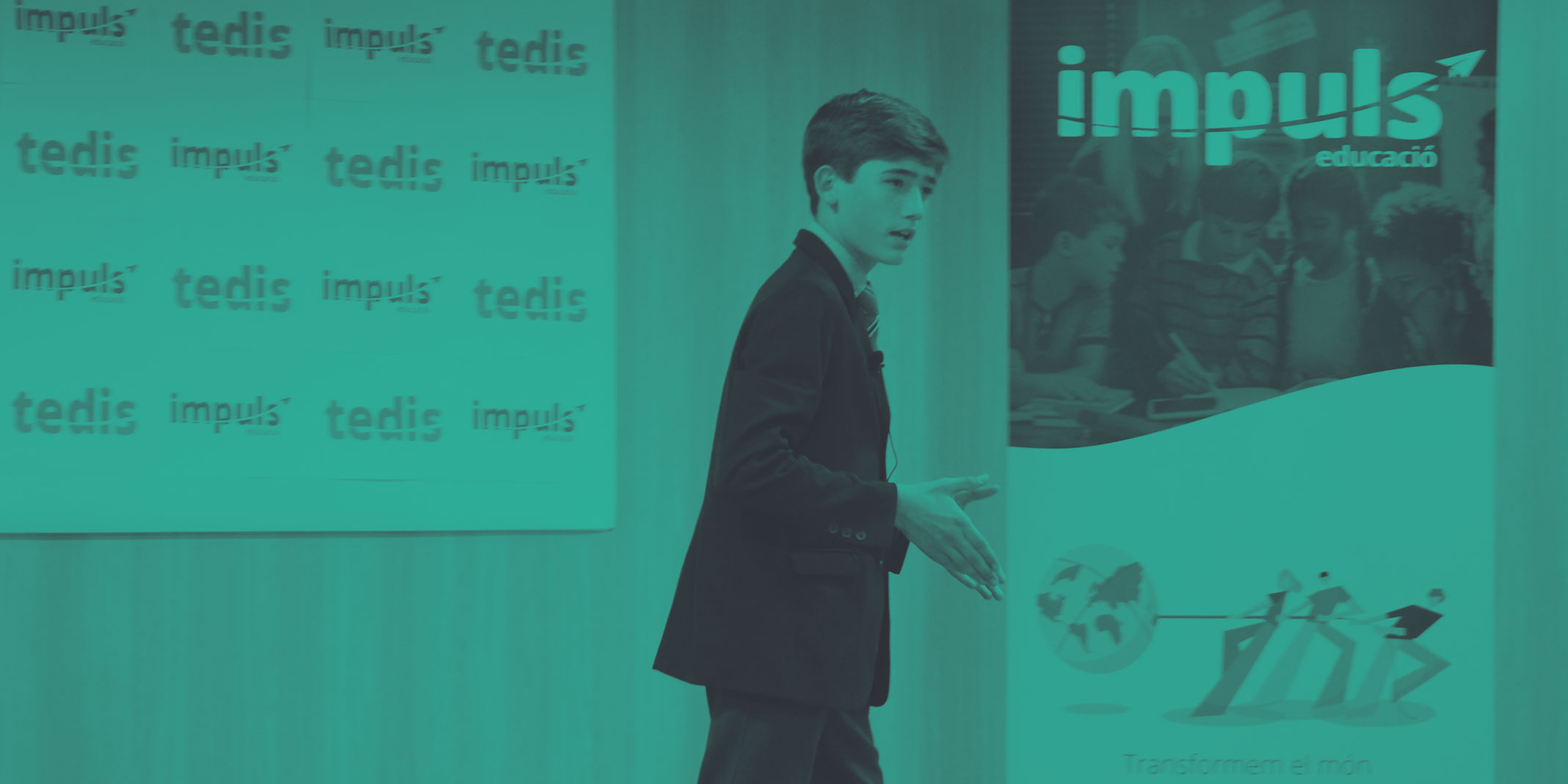
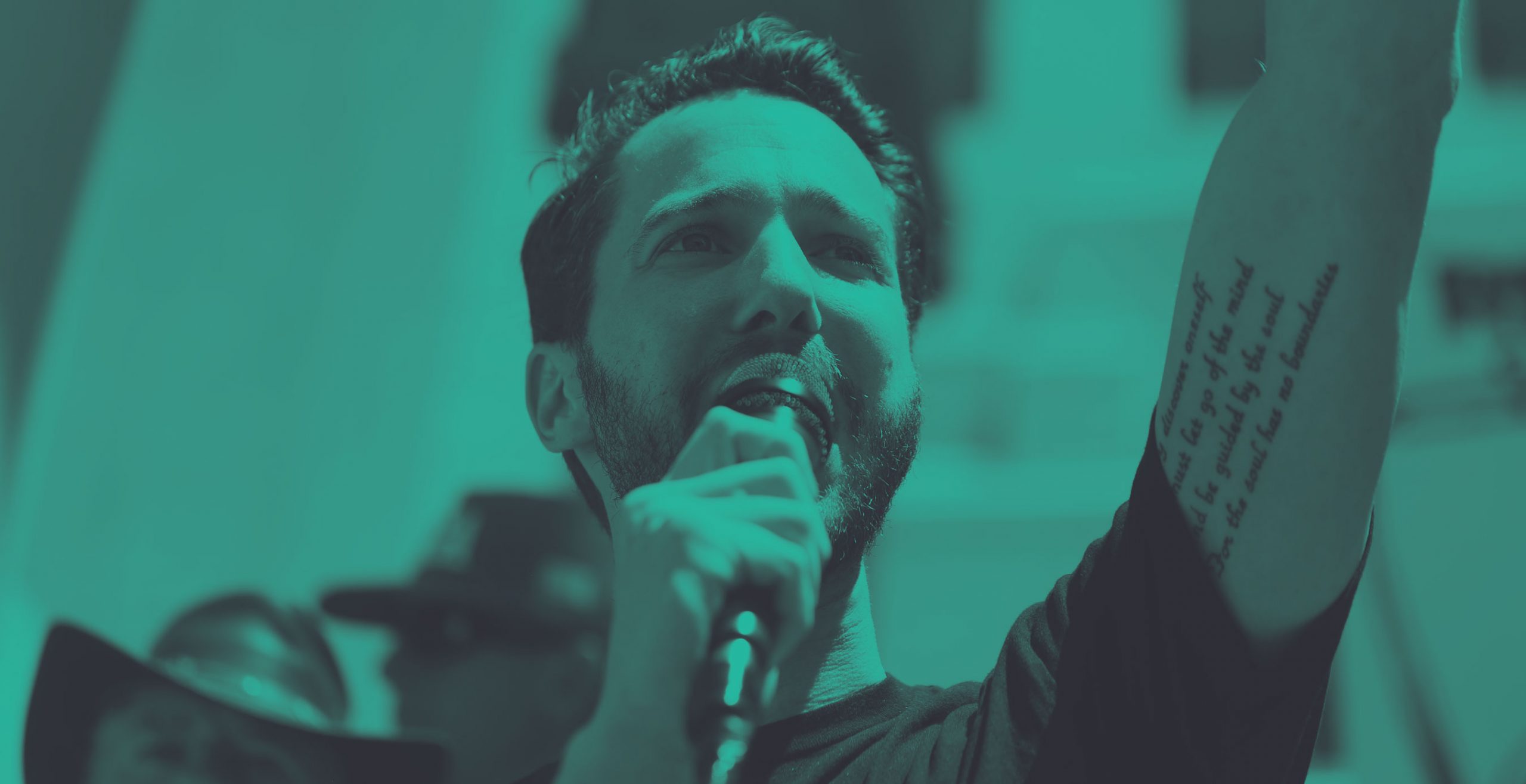

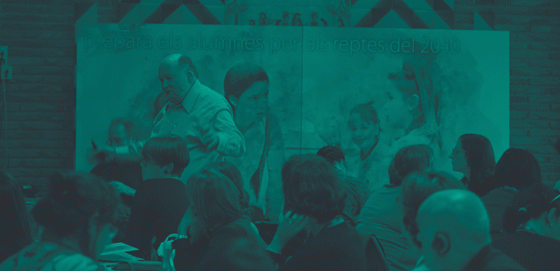
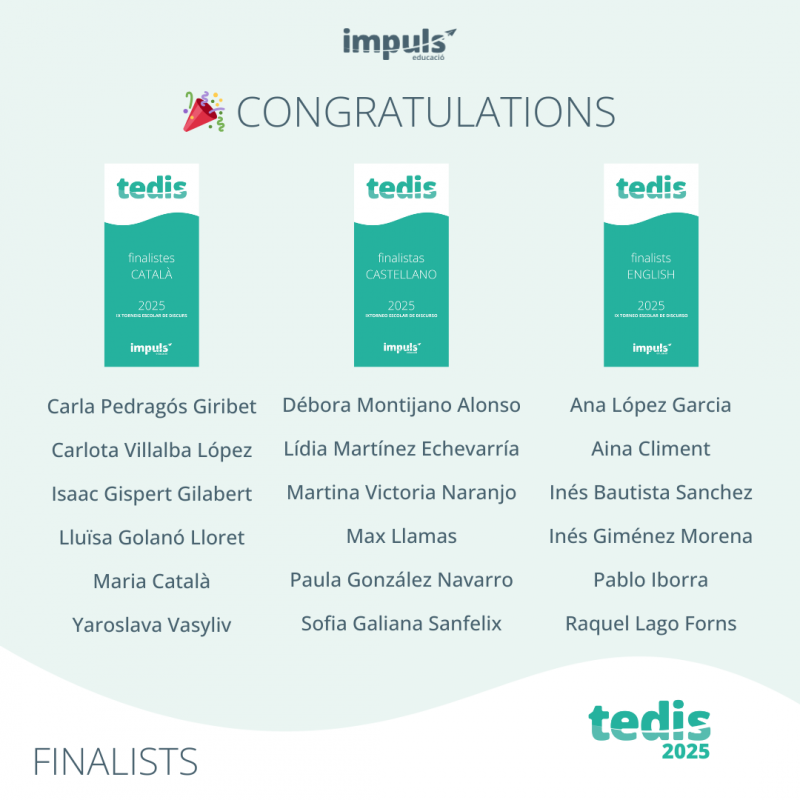

Leave A Comment